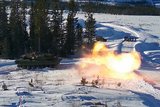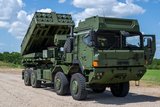Oshkosh Defense introduces TAK-4i system
Oshkosh Defense, a division of Oshkosh Corporation, has launched its next-generation Oshkosh TAK-4i intelligent independent suspension system to redefine ride quality, mobility and maneuverability standards for off-road military vehicles. The system's design leverages 10 years of operational experience in Iraq and Afghanistan, as well as the proven success of the Oshkosh TAK-4 independent suspension system, which has been used on more than 20,000 military vehicles to date.
"The Oshkosh TAK-4 system has brought unparalleled mobility to the battlefield on medium, heavy and MRAP vehicles," said Rob Messina, vice president of Defense Engineering for Oshkosh Defense. "Our engineers have taken mobility performance one step further with the TAK-4i to give troops a critical advantage in maneuverability, speed and durability as they navigate the off-road terrain that dominates today's battlefields."
Oshkosh developed the TAK-4i intelligent independent suspension system after studying military vehicles in action and calculating requirements for optimal speed, mobility and reliability on the battlefield. The TAK-4i system, which has completed more than 50,000 test miles with exceptional reliability, is scalable for use on light, medium and heavy tactical wheeled vehicles. With TAK-4i, a vehicle's height can be adjusted to maximize transportability and reduce the time and effort it takes to field vehicles.
The TAK-4i system delivers 20 inches of independent wheel travel, which is 25 percent more than other vehicles fielded with the US military, for new levels of off-road mobility. Improved shock absorption results in increased speed and significantly better ride quality for Warfighters who often travel off-road for hours at a time. The TAK-4i system is used on the Oshkosh Light Combat Tactical All-Terrain Vehicle (L-ATV) and the Oshkosh Light Combat Tactical Vehicle (LCTV), which are designed to deliver the protected mobility needed on remote, rugged and hostile landscapes.
Oshkosh vehicles including the MRAP All-Terrain Vehicle (M-ATV), Palletized Load System (PLS) A1, Medium Tactical Vehicle Replacement (MTVR) and Logistics Vehicle System Replacement (LVSR) use the Oshkosh TAK-4 independent suspension system and have delivered proven off-road mobility in Iraq, Afghanistan and other challenging landscapes around the world. Oshkosh was also selected by the US military to retrofit its TAK-4 system on MRAP vehicles produced by other manufacturers to deliver urgently needed off-road performance.
Source: Oshkosh Defense
More from Land Warfare
-
![Hungary set to begin using Hero 400 loitering munitions]()
Hungary set to begin using Hero 400 loitering munitions
Developed by Israel's Uvision and with systems being sold in the thousands to multiple European NATO countries and the US, the Hero family of loitering systems is also in production in the US and Italy, the latter through Rheinmetall.
-
![Light Reconnaissance Strike – enabling a vital mission set (Studio)]()
Light Reconnaissance Strike – enabling a vital mission set (Studio)
A new system-of-systems concept will unlock digital integration of sensors and weapons for Light Forces, allowing them to shape the battlefield environment on their own terms and upgrade legacy platforms.
-
![Lockheed Martin to look further afield for GMARS rocket system opportunities]()
Lockheed Martin to look further afield for GMARS rocket system opportunities
The HX truck is already in use in many NATO and allied countries around the world as a logistics vehicle and carrier for high-value systems, including missile firing weapons, so its use for the Global Mobile Artillery Rocket System makes logistical sense.






















